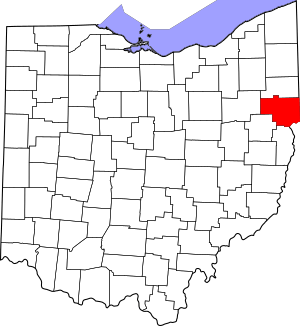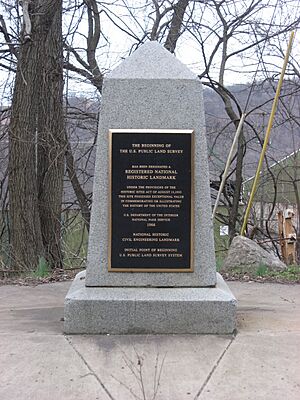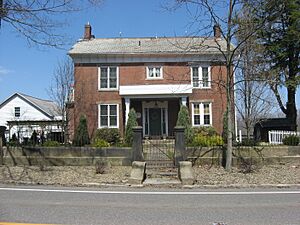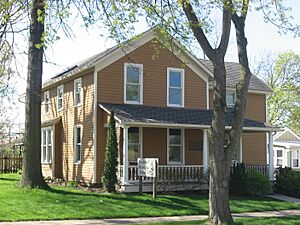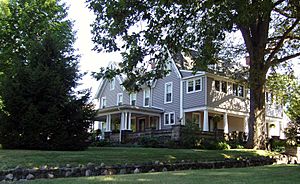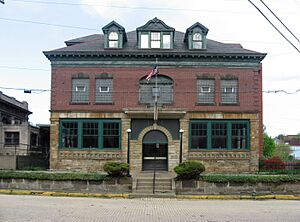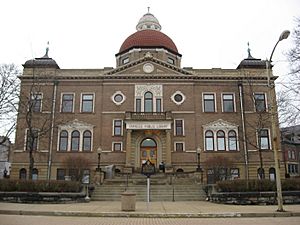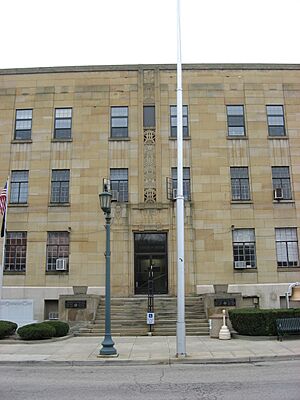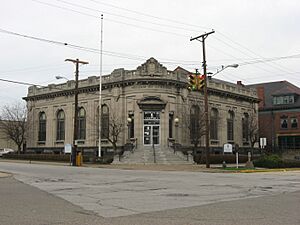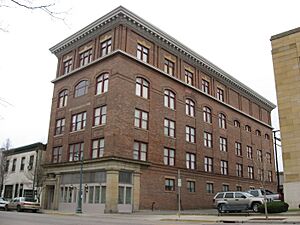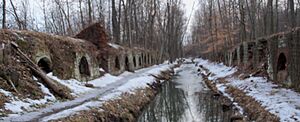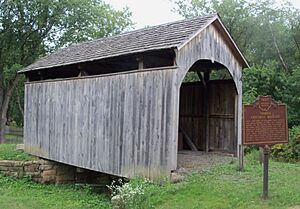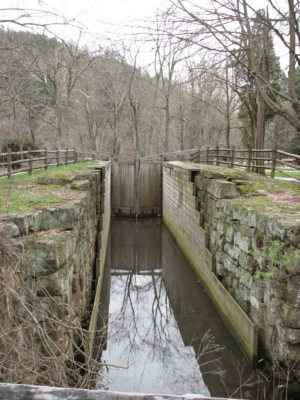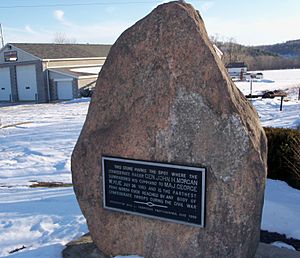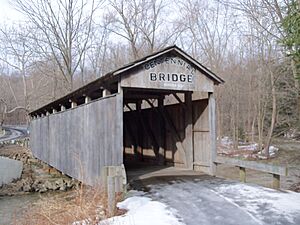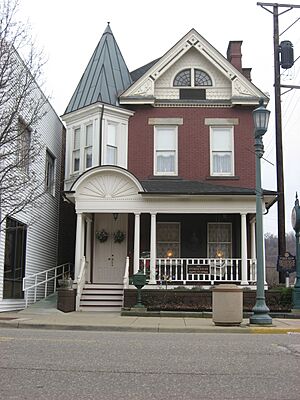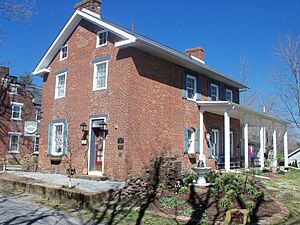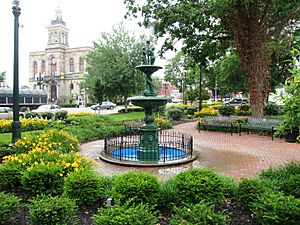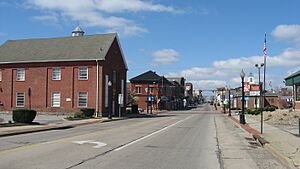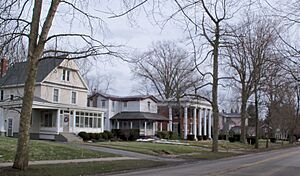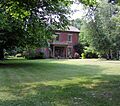National Register of Historic Places listings in Columbiana County, Ohio facts for kids
Welcome to Columbiana County, Ohio! This area is full of amazing history, and many of its special places are protected on the National Register of Historic Places. Think of this register as a VIP list for buildings, sites, and districts that are super important to American history, architecture, or culture. When a place is on this list, it means it's recognized for its unique story and is often preserved for future generations to enjoy.
In Columbiana County, there are 44 different places on this special list. One of them is even a National Historic Landmark, which is an even higher honor! Let's explore some of these cool historic spots and learn about their past.
Contents
Discovering Columbiana County's Historic Gems
The Beginning Point of the U.S. Public Land Survey
This spot, located on the border between Ohio and Pennsylvania, might look like just a point on a map, but it's incredibly important! It's where the United States started its official land surveying system in 1785. This system helped open up the vast Northwest Territory for settlement, allowing people to buy and own land in an organized way. It's a true landmark of how America grew.
Historic Homes and Farmsteads
Columbiana County is home to several beautiful old houses and farms that tell stories of past lives.
Hiram Bell Farmstead
Built in 1850, the Hiram Bell Farmstead is a great example of Greek Revival architecture. This style was popular in the mid-1800s and often features grand columns and symmetrical designs, making buildings look a bit like ancient Greek temples.
Burchfield Homestead
This house was the childhood home of Charles E. Burchfield, a famous American artist known for his watercolor paintings. Imagine growing up in a place that later becomes a piece of history itself!
Richard L. Cawood Residence
Built in 1923, this residence shows the architectural styles popular in the early 20th century. It was the home of Richard Cawood, adding to the rich history of East Liverpool.
Daniel Howell Hise House
The Daniel Howell Hise House in Salem was the home of a local abolitionist. Abolitionists were people who worked to end slavery in the United States. This house played a part in that important historical movement.
Godwin-Knowles House
This grand mansion was built in 1890. Later, it became the local Masonic Temple, a meeting place for a fraternal organization. It's interesting how buildings can change their purpose over time while still holding onto their history.
Important Public Buildings
Many public buildings in Columbiana County are also historic, showing how communities grew and what was important to them.
Carnegie Public Library
The Carnegie Public Library in East Liverpool holds a special place in Ohio's history. It was the very first library in the state to be funded by Andrew Carnegie, a famous businessman and philanthropist. Carnegie spent part of his childhood in East Liverpool, and he believed strongly in the power of public libraries.
East Liverpool City Hall
Built in 1934, the City Hall is a great example of Art Deco architecture. This style was very popular in the 1930s, known for its sleek lines, geometric shapes, and decorative elements. It was also a project of the Civil Works Administration, a government program during the Great Depression that created jobs.
East Liverpool Post Office (Museum of Ceramics)
This building, once the East Liverpool Post Office, is now the Museum of Ceramics. East Liverpool was famous for its pottery industry, so it's fitting that this historic building now celebrates that heritage.
Odd Fellows Temple
Another significant building in East Liverpool is the Odd Fellows Temple. Like the Masonic Temple, this was a meeting place for another fraternal organization, showing the importance of community groups in the past.
Unique Structures and Sites
Beyond homes and public buildings, Columbiana County has some truly unique historic sites.
Cherry Valley Coke Ovens
These ovens near Leetonia are a fascinating glimpse into industrial history. They represent the largest remaining site of "beehive" coke ovens in North America. These ovens were used to turn coal into coke, a fuel essential for making iron and steel during the industrial revolution.
Church Hill Road Covered Bridge
Built in 1870, this covered bridge is one of the shortest covered bridges used for public roads in the United States! It was moved in 1963 when the road was changed, but it still stands as a charming piece of history.
Gaston's Mill-Lock No. 36, Sandy and Beaver Canal District
Located in Beaver Creek State Forest, Gaston's Mill was built in 1837 and powered by water from Little Beaver Creek. Lock 36 was one of 90 locks on the Sandy and Beaver Canal. Canals were like water highways that helped transport goods before railroads became common. Both the mill and the lock have been restored, letting us see how things worked long ago.
John H. Morgan Surrender Site
This site marks where John Hunt Morgan, a Confederate general, surrendered during the American Civil War. His raid into Ohio was the farthest north any Confederate troops reached during the war. This spot is a reminder of a significant moment in American history.
Teegarden-Centennial Covered Bridge
Another beautiful covered bridge in the county, the Teegarden-Centennial Covered Bridge, adds to the charm of the area's historic landscape. Covered bridges were built to protect the wooden bridge structure from the weather, making them last longer.
Historic Districts
Sometimes, it's not just one building that's historic, but a whole group of them! These are called historic districts.
Diamond Historic District (East Liverpool)
This district includes parts of Market and East 6th Streets in East Liverpool, preserving a section of the city's past.
East Fifth Street Historic District (East Liverpool)
Along East 5th Street, this district showcases a collection of historic buildings that give us a peek into what East Liverpool looked like in earlier times.
East Liverpool Downtown Historic District
This larger district covers a significant part of downtown East Liverpool, including many important buildings and streets that tell the story of the city's development.
Hanoverton Canal Town District
Hanoverton was an important town along the Sandy and Beaver Canal. This district preserves the feel of a historic canal town, reminding us of the era when canals were vital for trade and travel.
Lisbon Historic District
The town of Lisbon also has a historic district that includes its town square and the Columbiana County courthouse. These areas show the heart of the community and its long history.
Salem Downtown Historic District
Salem's downtown area is also recognized as a historic district. It includes streets like Vine Avenue and East Pershing Street, preserving the character of this historic Ohio town.
South Lincoln Avenue Historic District (Salem)
This district in Salem focuses on South Lincoln Avenue, showcasing more historic architecture and the way the town developed over time.
These historic places in Columbiana County offer a fantastic way to connect with the past and understand how our communities and country have grown. Each one has a unique story waiting to be discovered!
Images for kids


